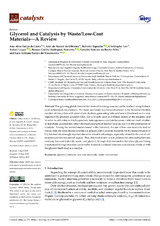Glycerol and Catalysis by Waste/Low-Cost Materials—A Review
Autor
Farias da Costa, Ana Alice
Oliveira, Alex de Nazaré de
Esposito, Roberto
Len, Christophe
Luque, Rafael
Rodrigues Noronha, Renata Coelho
Rocha Filho, Geraldo N. da
Santos do Nascimento, Luís Adriano
Editor
MDPIFecha
2022Materia
GlycerolCatalysis
Low-cost materials
Waste valorization
METS:
Mostrar el registro METSPREMIS:
Mostrar el registro PREMISMetadatos
Mostrar el registro completo del ítemResumen
The growing global demand for renewable energy sources can be reached using biofuels such as biodiesel, for example. The most used route to produce biodiesel is the transesterification reaction of oils or fats with short-chain alcohols, generating fatty acid esters (biodiesel) and a very important by-product, glycerol (Gly). Gly is widely used in different sectors of the industry, and in order to add value to this by-product, heterogeneous catalysis becomes a relevant tool, whether to transform glycerol into other chemical products of interest or even use it in the production of catalysts. Among the several studies found in the literature, the use of low-cost materials and/or wastes from the most diverse activities to prepare active catalytic materials for the transformation of Gly has been increasingly reported due to its valuable advantages, especially related to the cost of raw materials and environmental aspects. Thus, this brief review article presents the relationship between catalysis, low-cost materials, waste, and glycerol, through different studies that show glycerol being transformed through reactions catalyzed by materials produced from low-cost sources/waste or with the glycerol itself used as a catalyst.

